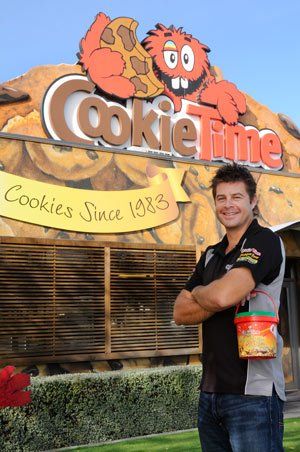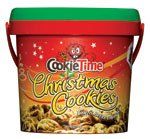Our Products
Latest News
NZ HortBin hits NZ shores
Click here to read more..
Viscount Plastics cleans up at the Pampito Awards
Click here to read more..
Viscount Plastics is the proud winner of the Chartered Institute of Logistics and Transport's prestigious "Safety, Security and Environmental Innovation" award for 2010.
Click here to read more...
COOKIE TIME PUTS BUCKET LOADS OF TRUST IN VISCOUNT PLASTICS
A long-term and trust-forged relationship with Viscount Plastics pays off at a critical time for Cookie Time
Case Study Outline:
Cookie Time entrusted its long-standing partner, Viscount Plastics, to develop newly designed packaging, featuring the latest labelling innovation-inmould labelling (IML) - to replace the iconic Cookie Time Christmas Cookies bucket.
The Challenge:
Changing the design of an iconic piece of packaging that has been part of the New Zealand public’s lives for over a quarter of a century is a major and risky undertaking for any business. This was the challenge Cookie Time faced when it decided it needed to update the design of its Cookie Time Christmas Cookies bucket. The bucket had remained largely unchanged since its inception in 1985, and its design was looking dated and tired, no longer reflecting the current Cookie Time branding.+
“We were mindful we were moving away from a bastion of our branding, as the previous bucket had been around for a long time,” says Cookie Time general manager Lincoln Booth. In addition, the bucket is the cornerstone of the annual Cookie Time
Christmas Cookies campaign – the company’s biggest sales drive each year, the success of which is crucial to Cookie Time’s annual results.
“Everything rides on the Christmas Cookies campaign. If we get it wrong it affects our entire year’s results,” says Booth. Therefore, Cookie Time needed to ensure that a replacement bucket lived up to the legacy of its predecessor, while serving the company’s needs for the next five years at least. They also needed a supplier flexible and nimble enough to meet the unpredictable demands of such a dynamic sales campaign.
The Solution:
Cookie Time turned to its long-term partner, Viscount Plastics, which has supplied the original Christmas Cookies bucket since 1985, to provide a new packaging solution. Viscount developed an innovative new bucket design incorporating groundbreaking new technology – Inmould Labelling (IML). Inmould labelling introduces pre-printed polymer labels into the moulding process to create a seamless fusion of label and rigid plastic packaging. IML proved to be far more cost- effective for Cookie Time, removing the need for a secondary labelling operation, saving the company labour and production costs.
“The application of labels was always labour-intensive and problematic. IML has taken a major headache out of the business,” says Lincoln Booth.The new technique also boosted the branding impact of the
product. Unlike paper or plastic labels, the inmould label does not peel off, ensuring that the Cookie Time branding remains on the bucket permanently. As a result, Cookie Time’s branding recognition remains intact long after the cookies have been eaten and the buckets are recycled for other uses, such making sand castles, holding clothes pegs or as pot plant holders.
The new bucket also improved food and safety standards for Cookie Time, while improving customer experience. Replacing the old bucket’s metal handle with a plastic handle, enabled Cookie Time to introduce a third layer of food safety inspection by enabling the products to be scanned by X-ray having already been packed in boxes for shipping. The new bucket design was received well by the public and Cookie Time enjoyed record sales in its 2009 Christmas Cookies campaign.
A relationship built on trust and quality:
Viscount Plastics and Cookie Time have developed a solid relationship over the past 25 years. “It is a relationship based on trust and quality,” says Booth.
This relationship has been forged through Viscount’s unfaltering ability to meet Cookie Time’s unique supply demands – especially during the annual Christmas Cookies campaign “Viscount’s flexibility, nimbleness and local presence has been vital to the success of the campaign,” says Booth. “Flexibility is vital in a dynamic campaign like the Christmas Cookies campaign, as we don’t know the final volumes until the last minute. We need a nimble operator that can work to our rhythm. Viscount is able to turn the tap on and off in terms of supply.”




